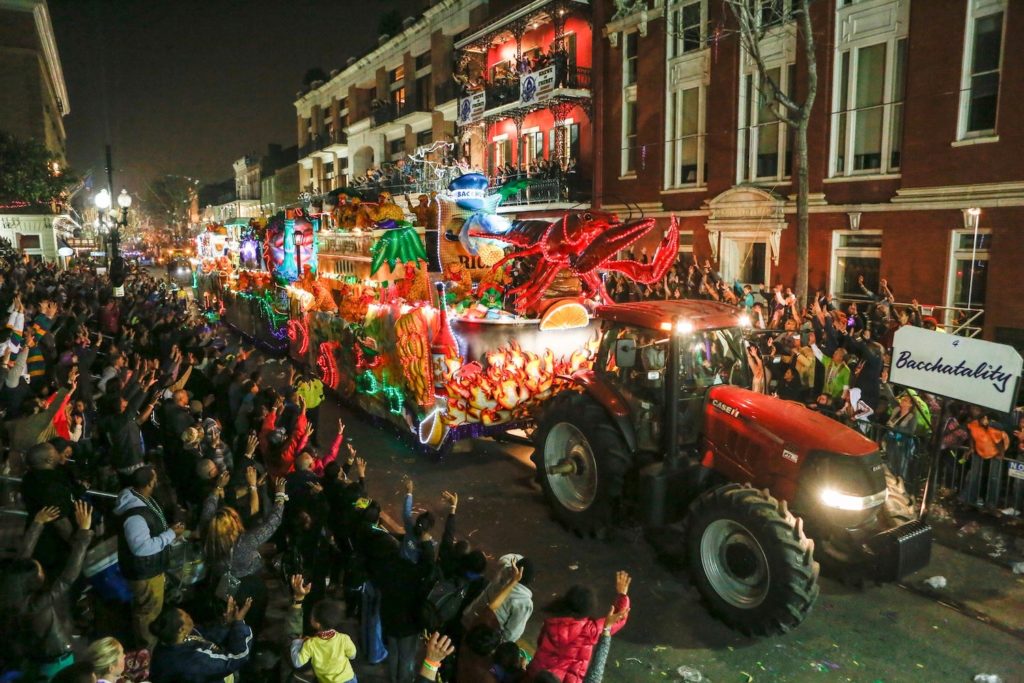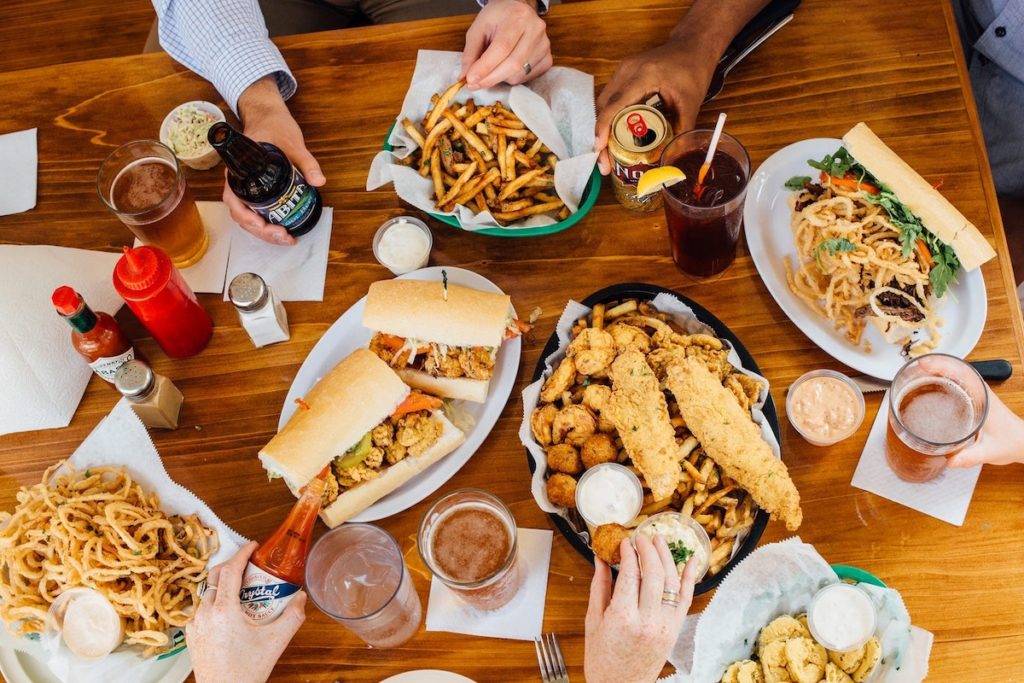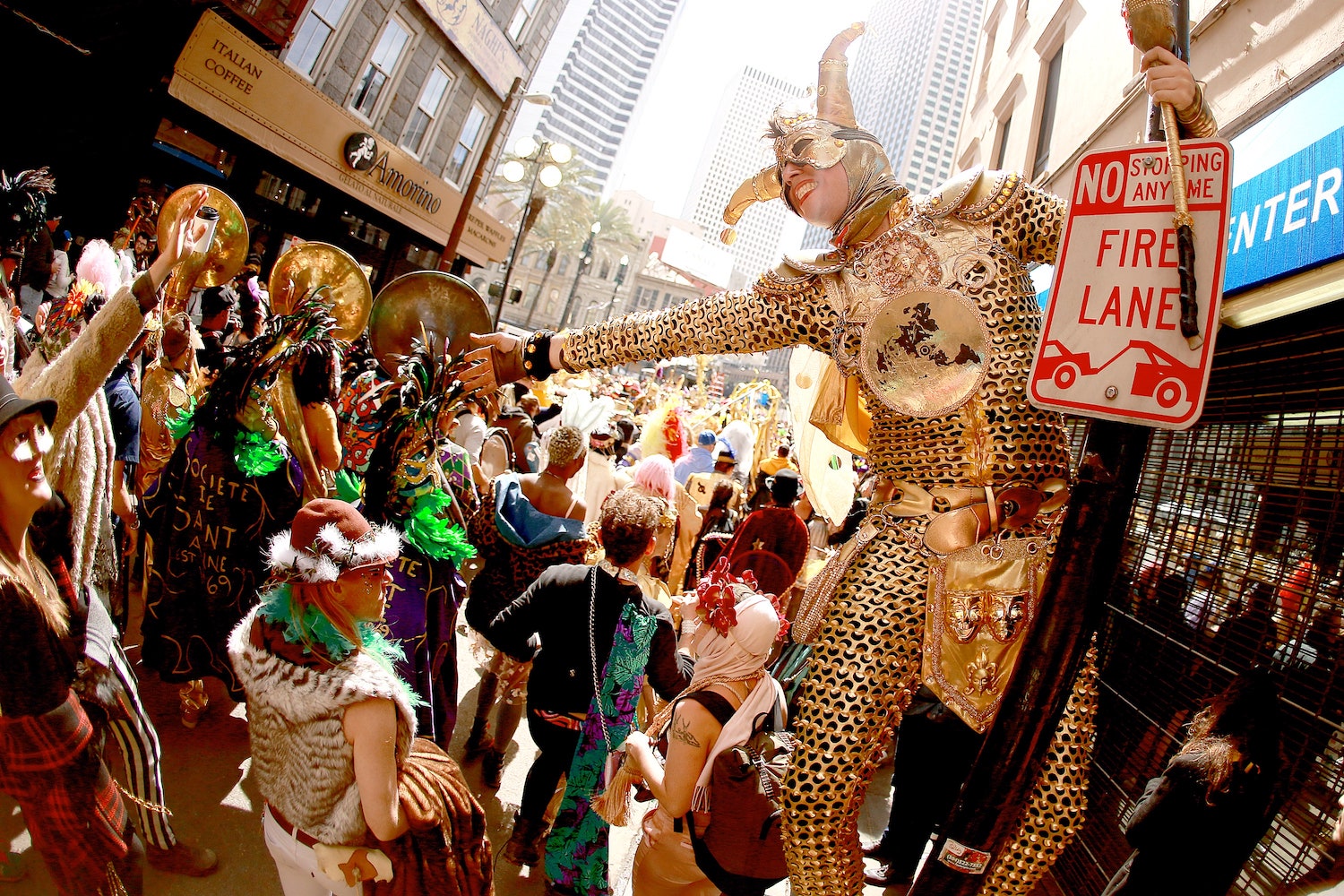🔗 New Orleans natives have their own traditions, separate from when the crowds descend.
It’s hard to think of a holiday with more sweeping generalizations surrounding it than Mardi Gras New Orleans, which is more associated with Bourbon Street buffoonery and skin-baring spring breakers than its deep roots in the region.
And yet, ever since the Mistick Krewe of Comus kicked off the first official Mardi Gras New Orleans parade on February 24, 1857, the “Greatest Free Show on Earth” has celebrated the city’s rich culture first and foremost. Ask the regulars who roll through religiously; it’s all about food, music, fashion, dance, and family, not Hurricane-addled hedonists. Whatever you do, don’t be that tourist.
The following guide should clear up the frequently asked questions that overwhelm many first-timers, from what happens when to the myriad ways one can blend in with the best of ‘em beautifully.

When is Mardi Gras this year?
February 25, 2020. Mardi Gras is French for Fat Tuesday, which means it’s the final countdown for New Orleans’ sizeable Catholic population (nearly 36 percent as of 2019) to eat, drink, and be merry before Lent kicks in. That’s when fun and frivolity is replaced by fish fries and fasting among churchgoing true believers.
How long does Mardi Gras last?
Here’s where things get a little confusing. Mardi Gras proper is a 24-hour affair, but it’s part of a broader day and night party that begins as soon as the 12 Days of Christmas end. January 6, to be exact. A handful of NOLA’s self-funded social clubs (a.k.a. krewes) hold parades in a few key neighborhoods then, sparking the Carnival season that doesn’t slow its roll until Ash Wednesday.
In other words, you don’t have to be in town on Mardi Gras to have a hell of a time, although it certainly doesn’t hurt. A better move is to scan the official parade schedule online; most krewes unveil their secret kings and floats in the second half of February. In fact, that is Mardi Gras among New Orleans natives: the two weekends before Fat Tuesday.
Another option is Family Gras, which brings more than 80,000 (fairly) well-behaved people to a different location outside downtown every year. Past live performers have included Taylor Swift, Billy Ray Cyrus, The Monkees, and Michael McDonald. The 2020 lineup at Clearview Center in Jefferson Parish is still TBD, but five different krewes are confirmed for exclusive parades throughout Valentine’s Day weekend.
What do you wear to Mardi Gras?
Elaborate masks and costumes are encouraged but not required. If you’d rather let the locals shine in the wardrobe department, any combination of purples, greens, and golds will be greatly appreciated. In case you’re curious, they stand for justice, faith, and power, and double as the color palette of king cakes, which we’ll get to in a minute.

Everything you need to know about Mardi Gras parades and parties
A common misconception: that there’s an essential Mardi Gras bash in the French Quarter. Turns out the most ornate and over-the-top gatherings are in New Orleans’ Uptown (Krewe of Bacchus on February 23 at 5:15 p.m., and Krewe of Orpheus on February 24 at 6 p.m.) and Mid-City (Krewe of Endymion on February 22 at 4:15 p.m.) neighborhoods, making the weekend before Fat Tuesday the most popular time to visit.
It doesn’t matter which parade(s) you choose to watch; they’ll all give you a sense of the Mardi Gras spirit. Be sure to watch out for the “signature throws” each krewe tosses into its respective crowd. Reaching well beyond the familiar realm of plastic beads and doubloons, they include hand-decorated coconuts (Krewe of Zulu at 8 a.m. on February 25), shoes (Krewe of Muses at 6:30 p.m. on February 2), genie lamps (Krewe of Alla in the early evening on February 14), and shrimp boots (Krewe of Carrollton just before noon on February 16).
Where to stay for Mardi Gras
Rates around the parade routes peak during the long weekend leading into Mardi Gras, with the most convenient hotels booking up months ahead of time. One compromise would be securing a School House Grande Loft or Rectory Classic Room at Hotel Peter & Paul before it’s too late. They both clock in at under $500 a night despite the citywide demand for decent accommodations. The converted 19th century church is also located in the slightly more laid-back, but no less historic Marigny district, which is halfway between new (the increasingly trendy Bywater neighborhood) and old (the French Quarter) New Orleans. If you must be in the middle of the action or are looking for a more complete breakdown of what may or may not be available, these are our favorite hotels in New Orleans.

What to eat during Mardi Gras
King cake, of course. A culinary symbol of the entire Carnival season, the iconic purple, green, and gold pastry is based on a classic brioche recipe but available in a wide range of welcome riffs. One of the most hotly pursued local hits is Dong Phuong Bake Shop. The Vietnamese bakery specializes in cream cheese and cinnamon variations that are limited to walk-ins and two cakes per customer despite it being located a good 20 minutes outside central New Orleans. Should you want to eat something other than frosting and sugar, we broke some of the very best po boys, brunches, and beignets, as well as a more general overview of crucial restaurants and bars in the French Quarter, Bywater, and Warehouse districts.
What else to do in New Orleans during Mardi Gras
As if all of those costumes and krewes weren’t entertaining enough, New Orleans is still a world-renowned destination for live music, especially jazz. The best stretch to see it all isn’t the French Quarter, either, Preservation Hall aside. It’s Frenchman Street, which comes alive every night at seminal clubs like The Spotted Cat , d.b.a., and Blue Nile. Daytime detours include the restorative walking paths and art galleries in City Park, the National WWII Museum, and the “float den” at Blaine Kern’s Mardi Gras World, “where every day is Mardi Gras!” no matter what time of year.

